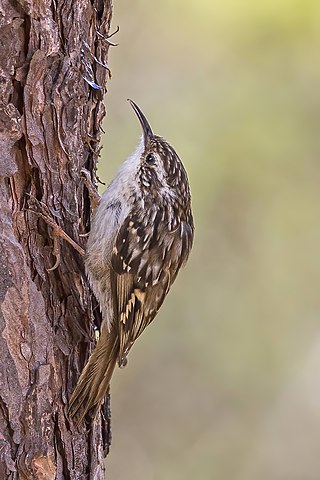
The bushtits or long-tailed tits are small passerine birds from the family Aegithalidae, containing 13 species in three genera, all but one of which (Psaltriparus) are found in Eurasia. Bushtits are active birds with long tails compared to their size, moving almost constantly while they forage for insects in shrubs and trees. During non-breeding season, birds live in flocks of up to 50 individuals. Several bushtit species display cooperative breeding behavior, also called helpers at the nest.

The treecreepers are a family, Certhiidae, of small passerine birds, widespread in wooded regions of the Northern Hemisphere and sub-Saharan Africa. The family contains eleven species in two genera, Certhia and Salpornis. Their plumage is dull-coloured, and as their name implies, they climb over the surface of trees in search of food.

The Indian spotted creeper is a small passerine bird, which is a member of the subfamily Salpornithinae which is placed along with the treecreepers in the family Certhiidae. This small bird has a marbled black and white plumage that makes it difficult to spot as it forages on the trunks of dark, deeply fissured trees where it picks out insect prey using its curved bill. It is found in patchily distributed localities mainly in the dry scrub and open deciduous forests of northern and central peninsular India. It does not migrate. Their inclusion along with the treecreepers is not certain and some studies find them more closely related to the nuthatches while others suggest a close relation to the wallcreeper. They lack the stiff tail feathers of treecreepers and do not use their tail for supporting them while creeping vertically along tree trunks.

The Eurasian treecreeper or common treecreeper is a small passerine bird also known in the British Isles, where it is the only living member of its genus, simply as treecreeper. It is similar to other treecreepers, and has a curved bill, patterned brown upperparts, whitish underparts, and long stiff tail feathers which help it creep up tree trunks. It can be most easily distinguished from the similar short-toed treecreeper, which shares much of its European range, by its different song.

The short-toed treecreeper is a small passerine bird found in woodlands through much of the warmer regions of Europe and into north Africa. It has a generally more southerly distribution than the other European treecreeper species, the common treecreeper, with which it is easily confused where they both occur. The short-toed treecreeper tends to prefer deciduous trees and lower altitudes than its relative in these overlap areas. Although mainly sedentary, vagrants have occurred outside the breeding range.

The brown creeper, also known as the American treecreeper, is a small songbird, the only North American member of the treecreeper family Certhiidae.

The flamecrest, also known as Taiwan firecrest, is a species of bird in the kinglet family, Regulidae. It is endemic to the mountains of Taiwan.

Certhia is the genus of birds containing the typical treecreepers, which together with the African and Indian spotted creepers make up the family Certhiidae.

Salpornis is a genus of bird which is usually included in the family Certhiidae. The genus has in the past been included with the nuthatches in the family Sittidae or placed in a family of its own, the Salpornithidae. Molecular phylogenetic analyses show them to be definitely within the Certhioidea but still leaves some uncertainty about their placement in relation to the genera Sitta, Tichodroma and Certhia. While they appear similar to the treecreepers (Certhia), they do not use their tails to support them while climbing and some molecular evidence shows them to be closer to the nuthatches (Sitta) while another study suggests a closer relation to the wallcreeper Tichodroma muraria. The generic name is derived from the Greek salpinktes for wren and ornis for bird.

The sombre tit is a member of the tit family found in southeast Europe and southwest Asia. Sombre tits occur in low density in thin woodlands at the elevation range between 1000 and 1600 metres above sea level.

The Sichuan treecreeper is a rare species of bird in the treecreeper family, Certhiidae.

The Bonin grosbeak or Bonin Islands grosbeak is an extinct finch. It is one of the diverse bird taxa that are vernacularly called "grosbeaks", but it is not closely related to the grosbeaks sensu stricto. Many authorities place the species in the genus Carpodacus, but some place it in its own genus, Chaunoproctus. A 2013 genetic analysis found it to be a relatively basal member of the group, more derived than the common rosefinch, but with no close relatives, with an estimated divergence time from other members of the group around 12.5 million years ago.

The Sikkim treecreeper is a species of bird in the treecreeper family.

The white-browed tit is a species of bird in the tit family Paridae. It is endemic to the mountain forests of central China and Tibet.

The Nepal cupwing(Pnoepyga immaculata), also known as the Nepal wren-babbler or immaculate cupwing, is a small species of passerine bird in the family Pnoepygidae. It is native to Uttarakhand, Himachal Pradesh, Tibet, and Nepal. It is found in dense montane forest in the Himalayas.

Hodgson's treecreeper is a small passerine bird from the southern rim of the Himalayas. Its specific distinctness from the common treecreeper was recently validated.

The Caspian tit is a passerine bird in the tit family. It breeds in the deciduous mountain forests of northern Iran, just extending into Azerbaijan.
The Chinese beautiful rosefinch is a true finch species. It is one of the rosefinches that might belong in the genus Propasser. It is found in China and Mongolia. Its natural habitats are temperate shrubland and subtropical or tropical high-altitude shrubland.

Regulus is a genus of bird in the family Regulidae.


















